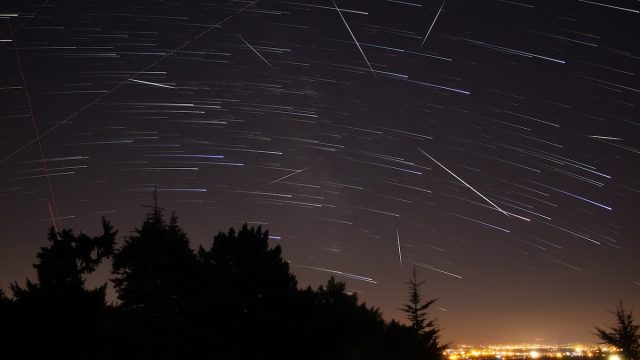Meteor Shower That Produces Up to 15 “Fireballs” Per Hour Will Peak This Weekend—How to See It

If you have a penchant for all things space (or just have FOMO from missing this year’s Halloween comet), consider this your official celestial events weekend update. The Leonid meteor shower is expected to reach peak activity during the early morning hours of Nov. 17 and Nov. 18, the American Meteor Society (AMS) reports. The annual shower, whose name originates from the constellation Leo the Lion, produces the world’s fastest meteors, clocking in at 44 miles per second and glowing at altitudes of around 96 miles. That is to say, it’s a sight you most definitely won’t want to miss.
RELATED: Rare Star “Explosion” Will Soon Light Up the Night Sky, NASA Says—Here’s How to See It.
The Leonids are an annual occurrence that began on Nov. 3 and runs through Dec. 2; however, according to Smithsonian Magazine, the meteor showers peak when dust, rock, and ice particles from comet 55P/Tempel-Tuttle enter Earth’s atmosphere and burn up, creating dazzling streaks of light in the night sky.
This phenomenon will occur during the early morning hours of Nov. 17 and again at midnight until the sun rises on Nov. 18.
The Leonids are a bit of a mystery and can be quite unpredictable, according to space experts. Although the Leonids occur every year in mid-November, it takes comet 55P/Tempel-Tuttle 33 years to complete a single orbit around the sun. When it does, a “Leonid storm” takes place, which is basically a meteor shower on steroids.
A storm of this magnitude can produce “hundreds to thousands of meteors” per hour, says the National Aeronautics and Space Administration (NASA). The difference between a meteor storm and a meteor shower is “defined by having at least 1,000 meteors per hour.”
The Leonids have only produced six meteor storms in their lifetime, including in 1833, 1866, 1996, 1999, 2001, and 2002. The next storm isn’t expected until 2031, although AMS predicts that the Earth won’t encounter a significant dense cloud of debris until 2099.
As for this year’s Leonids meteor shower, NASA says onlookers will be treated to a “bright” and “colorful” display of up to 15 “fireballs” per hour. What is a fireball, you ask? Fireballs consist of “cometary material” with very bright magnitudes. Their explosions, AKA performance, are more distinct and much brighter than an average meteor streak.
RELATED: 8 Amazing Things You Can See in the Night Sky Without a Telescope.
Viewers may also witness something called “Earth-grazers.” These types of meteors are known for their long, colorful tails and streak closer to the horizon line, per NASA.
Most meteor showers can be spotted without binoculars and in areas with no obstruction, meaning bright city lights, tall buildings, and condensed trees. But viewers will have their work cut out for them this weekend when the waning gibbous moon reaches near-peak luminosity. The good news is that the Leonids can be spotted in any direction, so stargazers in all 50 states will have the chance to witness this celestial event.